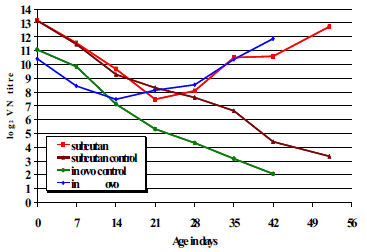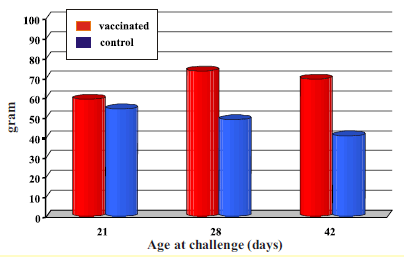



Control of Infectious Bursal Disease in Broilers by Early (in ovo and day-old) Vaccination
By V. Palya, K. Forgách, T. Süveges, M. Kelemen, J. Mészáros and J. Benyeda.Introduction
The infectious bursal disease virus (IBDV) is a widespread, resistant virus of great economic importance for the poultry industry. The only effective way of providing protection against this harmful virus is vaccination of receptive animals at the right time. In young broiler normally variable, but high levels of maternal antibodies persist, that in most cases prevents the traditional live vaccines from inducing active protection after single application. The recently developed IBDV immuncomplex vaccine (intermedier plus vaccine virus strain plus neutralizing specific antibody to IBDV) may be applied in ovo or at day old. A great advantage of this type of vaccine that, depending on the maternal antibody level of each vaccinated animal, the vaccine virus starts to replicate at the most appropriate time and provides active immune response to the animals.
Materials and Methods
Vaccine
Cevac Transmune IBD®
Vaccination
In ovo: embryonated eggs at 18 days of age (1 dose: 0.05 ml), derived from a parent flock vaccinated against IBDV several times

Subcutan: day old chicks (1 dose: 0.01 ml) with maternal antibody to IBDV

Serology
Sampling at 0, 7, 14, 21, 28, 35 and 42 days of age, virus neutralization (VN) test on chicken embryo fibroblast (CEF) against 300-500 TCID IBDV
Challenge
At 14, 21, 28, 35 and 42 days of age with vvIBD (MOH-94) 103 EID /animal 50 per os
Histology
Bursa sampling on days 0, 7, 14, 21, 28, 35; hematoxylin-eosin (HE) staining
Body weight gain determination
Body weight was measured at the time of the challenges and 10 days after the challenges
B:B index determination
B:B index was calculated according to B. Lucio formula.
Evaluation of protection
Gross and histopathology of bursa four days post challenge
Body weight gain during the 10-day period following challenge
Conclusions
- Immunization of broilers with CEVAC Transmune IBD® in ovo or subcutan at one day of age induced a fully protective immune response against vvIBDV challenge before the depletion of the maternal antibodies.
- The active immune response started when the maternal antibody level to IBDV dropped to log2 7-8.
- CEVAC Transmune IBD®-induced immunity lasted throughout the fattening period.
- Following challenge, the development and body weight gain of the immunized animals reached the expected value for the given technology and was significantly better than the controls.
Results
Serology
The starting maternal antibody levels in the subcutan and in ovo vaccinated group were log2 10.39-13.18, which decreased to log2 6.62-7.45 respectively. Then, active immune response was measured starting from three weeks of age onwards, as demonstrated by the increase of the antibody levels (log2 8.07-8.10) both after in ovo and subcutan immunization. The antibody level increased further during the growing period (Figure 1).

Histology and B:B index
In the in ovo immunized birds, bursa lesions characteristic of the vaccine virus were detected in 65% of the bursa samples at 21 days of age, while signs of regenerations were already observed by day 28.
In the subcutan immunized animals, at day 14, 70 per cent of the samples displayed lesions characteristic of the vaccine virus. This has increased to 100 per cent by day 21, while signs of regenerations were also detected at this time.
In the in ovo immunized animals the effect of the vaccine virus was detected on day 21, as indicated by the reduction of the B:B index.
In the subcutan immunized group the reduction of the B:B index was already observed at day 14 indicating, the start of the replication of the vaccine virus. The index in both group decreased till day 28, after which it has increased indicating that the bursa regeneration of process has started.
| Table 1. B:B index | ||||||
| Day/Group | 7th day | 14th day | 21st day | 28th day | 35th day | 42th day |
|---|---|---|---|---|---|---|
| In ovo | 1.16 | 0.95 | 0.52 | 0.28 | 0.34 | 0.45 |
| Subcutan | 1.17 | 0.61 | 0.38 | 0.24 | 0.48 | 0.67 |
| In ovo – MAB 13.18 log2 VN Subcutan – MAB 10.39 log2 VN |
||||||
Challenge
At day 21, in the in ovo group, challenge with the vvIBDV strain resulted in 35 per cent protection. Challenge on day 28 and afterwards resulted in 100 per cent protection, indicating the full development of the protective immunity.
In the subcutan immunized group 70 per cent protection was observed by day 14, which turned to full, 100 per cent protection by day 21. No gross pathological or histological changes could be observed in the bursa at day 21 that would point towards to replication of the challenge virus.
| Table 2. Protection post challenge | ||||
| Age at challenge | In ovo | Subcutan | ||
|---|---|---|---|---|
| Vaccinated | Control | Vaccinated | Control | |
| Protection % | Protection % | Protection % | Protection % | |
| 14 days | nd | nd | 70 | 0 |
| 21 days | 65 | 10 | 100 | 0 |
| 28 days | 100 | 0 | 100 | 0 |
| 35 days | 100 | 0 | 100 | 0 |
| 42 days | 100 | 0 | 100 | 0 |
Body weight was measured at the time of the challenges and 10 days after the challenges. The body weight of vaccinated animals were as expected for their type and age, while the non vaccinated control animals showed significant retardation of growth both following challenge at day 28 (p<0.0019) and day 42 (p<0.001) (Figure 2).

References
Benjamin Lucio and Stephen B. Hitchner : Infectious bursal disease emulsified vaccine: Effect upon neutralizing-antibody levels in the dam. Avian Diseases 23: 466-478, 1979.
J.M.Sharma: Embryo vaccination with infectious bursal disease virus alone or in combination with Marek's disease vaccine. Avian Diseaes 29:1155-1169, 1985.
C.E.Whitfill et al: Determination of optimum formulation of a novel infectious bursal disease virus (IBDV) vaccine constructed by mixing bursal disease antibody with IBDV. Avian Diseases 39: 687-699, 1995.
E.E.Haddad et al: Efficacy of a novel infectious bursal disease virus immune complex vaccine in broiler chicken. Avian Diseases 41: 882-889, 1997.
M.Kelemen et al: Pathological and immunological study of an in ovo complex vaccine againts IBD. Acta Veterinaria Hungarica 48: 443-454, 2000.









